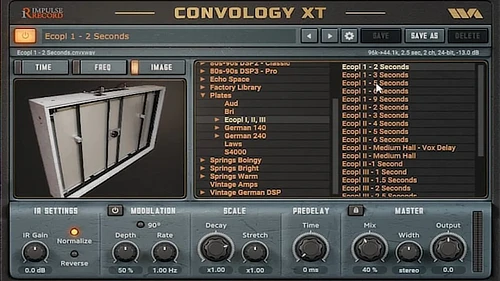The provision of effects programs further extends this versatility, making the Klark Teknik DN 780 the most powerful acoustic processing package currently available.
Not happy with current designs with narrow fields of useful application, our research has led to a new operating concept for the Klark Teknik DN 780 to extend versatility, backed by an advanced high speed digital signal processor designed to handle the necessarily complex computations.
This technical innovation results in extremely high-density reverberation with convincing small room performance, authentic concert hall reverberation and a wide-ranging choice of basic ‘acoustic spaces ‘, both natural and unnatural, selected by the innovative reflection ‘Pattern’ control.
The remaining controls give accurate adjustment of all reverberation parameters, including ‘Roam size’, and when used with the ‘Pattern’ control these allow the engineer to create unique acoustic environments of virtually any type.
A number of factory-set acoustic simulations are available: see ‘Software‘ section. It is important to note that all these very different sounds were created using only the controls you have available: for example, there is no dedicated ‘Room’ program as such. A room sound is created using the appropriate pattern (‘2’), and adjusting other parameters as required.
The factory-set memory locations should be used, then, as a reference point from which to create your own variation, forget the limitations of a dedicated system and let your creativity reign.
Fifty non-volatile memories are available for entering user variations and the sequence function allows instant recall of up to 16 factory or user memories in required order, allowing rapid movements through a series of previously planned acoustical settings for mix-down, film dubbing, t.v. production or live performance.

The Klark Teknik DN 780 performs to the highest specification and is engineered using the latest technology to keep component count down and reliability up. Electronics use a semi-modular system of construction distributed logically on six printed circuit boards, eliminating unreliable edge connectors whilst avoiding the servicing problems of single board systems.
The Klark Teknik DN 780 is a compact 2U, 19-inch rack mounting device equally at home in the recording studio, dubbing suite, broadcasting studio or on the road.
Audio connectors are 3 pin XLR style, wired to the standard configuration. The input is electronically balanced as standard with transformer balancing available as an option. Outputs are transformer balanced.
The Klark Teknik DN 780 gives the operator enormous scope to use his creative skills to the full. To achieve this, wide ranging control is provided for all parameters; however, the basic operating procedure remains both simple and intuitive, giving immediate access to a wide range of factory set acoustic simulations. A thorough understanding of this section will then enable the full capabilities of the DN780 to be realised.
The provision of 50 user memories, sequence function and remote-control unit means that ultimately, in practice, operation is reduced to pressing a single key (“Sequence”) on the remote unit and occasionally modifying a parameter using the remote sliders.
Unlike many dedicated reverberation only devices, the Klark Teknik DN 780 is also capable of running a number of different effects programs. These cover a wide range of applications from straight delay, through a variety of echo effects to the surreal sound of the Infinite Room Program.
The combination of excellent audio performance and digital signal processing power results in a performance advantage over most existing effects and echo devices. A poor man’s AMS RMX16? No, it is much better than that!










